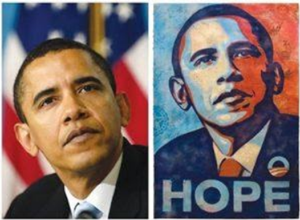Chapter 5: Using information ethically
5.7 Understanding fair use
Fair use refers to specific legal exceptions that let you use copyrighted material without having to ask for permission or pay any fees. One reason fair use exists is to make it easier for copyrighted material to be used in universities and other educational settings, where these materials are taught, shared as course readings, and used for research. Another example of fair use is when an artist or musician reuses or references someone else’s creative work in something they create (e.g. the parody songs of “Weird Al” Yankovic).
Fair use is determined by analyzing four factors:
- The purpose and character of the use,
- The nature of the copyrighted work being used,
- The amount and substantiality of the work being used, and
- The use’s effect upon the original work’s value.

This means that not every reuse of copyrighted works is considered fair use. In one high profile example, graphic designer Shepard Fairey based his well-known “Hope” poster on a photograph of Barack Obama that was taken by photographer Mannie García, who was working for the Associated Press (AP).
Fairey did not acknowledge his source. When the source was revealed, Fairey tried to defend his work as fair use. However, the AP disagreed and took Fairey to court, where a judge decided Fairey’s poster violated copyright law and was not fair use. Below, we review the four factors for determining fair use in more detail and how Fairey’s work fails to meet them.
Purpose and character of the use
This factor considers what you’ll be doing with the original work you use. Fair use favors uses that:
- transform a work instead of using it as-is,
- radically and significantly change a work from the original,
- provide a commentary, critique, or parody of the original,
- add new meaning to a work through its use, or
- facilitate teaching or learning.
In the case of the “Hope” poster, the graphic designer attempted to transform the photograph by color blocking it; however, he did not significantly transform the photo from the original. In addition, since the original was not cited or acknowledged, it would be difficult to consider Fairey’s work as a commentary or critique of the original.
Nature of the copyrighted work
This factor considers the purpose and type of the original work you want to use. Specifically, fair use favors uses that:
- include factual material, such as biographies or technical articles, rather than creative works such as fiction writing, poetry, or music; and
- reuse published works that have already been shared, rather than unpublished works, which have not yet been shared.
Using someone else’s artistic work, such as Mannie García’s photograph, is less likely to be considered fair use. Copyright law was created to protect authors and artists so that they would create more. Mannie García’s photograph was his own creative expression, another reason why the judge determined that Fairey’s derivative poster was not fair use.
Amount and substantiality
This factor considers the amount of the original work you are reusing, and how substantial that portion is. Fair use supports the use of a small or less important portion of a work. Specifically, fair use favors uses that include:
- only a part, not all of the original work, or
- a nonessential piece of the original work, rather than the “most important” or “best” piece.
Fairey’s poster used nearly all of Mannie García’s photo. While the poster omits the flag in the background of García’s photo, the most substantial part, Barack Obama’s face, was included in its entirety. This does not support the argument that his poster was fair use.
Effect upon the work’s value
This factor considers whether your use could impact the sale and perception of the original work. Fair use favors uses that:
- do not negatively impact the market for the original work, such as how scanning a workbook replaces the need to buy the original workbook, and
- are not easily mistaken as the original work, and do not otherwise overshadow or replace the original.
The photograph in this example was Mannie García’s original creation. However, Shepard Fairey’s derivative work became so famous that most people would never know the poster was based on someone else’s work. In other words, you could say that Mannie García’s photograph and creative vision were devalued.
As we’ve seen in this example, fair use is determined by considering not one or two but all four factors. One common misconception is that everything is fair use if the material is used for an educational purpose. That’s an oversimplification. The four key factors for determining fair use should all be considered together.

